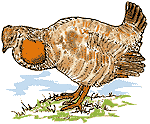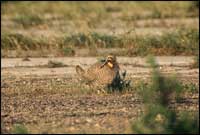Attwater's Prairie Chicken
Habitat Restoration and Maintenance
Most of the coastal prairie has now been lost to urbanization and agriculture making it necessary to not only acquire additional lands for the birds to live on, but also to restore and maintain that land as an effective, optimal habitat for this species.

To do this, they must control the encroachment of woody species into the traditional prairie habitat. One of the tools they use is prescribed burning, burning 2000 to 3000 acres each January or February. Burning not only removes the woody vegetation, but also invigorates the grasses, removing the dead stems and encouraging new growth.
Grazing, by bison or cattle, shapes the grassland into clumps with spaces between them, allowing room for the chicks to pass through and spaces for the female to develop her nest in a sheltered area.
Very dense stands of grass are generally avoided, but are used for shade during the hot and humid summer months, and for protection against inclement weather and predators. Dense grasses are critical though during nest seasons since that is where the hens build their nests.
Habitat is degraded by agriculture, urbanization, and encroachment of woody species. A significant encroaching species in recent years has been Chinese Tallow, which has turned many acres of prairie into tallow forests.
Sometimes it is necessary to apply herbicides to control brush species never before seen on the prairies. Not only is brush unnatural, the additional hiding places provided for the predators increases their pressure on the prairie chickens. Refuge staff manage for a reduced mammalian predator count during the nesting season. In recent years, few nests on the prairie have survived because of mammalian pressure. By reducing mammalian pressure during the nesting season, these nests are given a chance to survive.
Refuge staff also make a concerted effort to restore wild prairie where ever practical on the refuge. Formerly cultivated fields are often seeded with seed collected in adjacent prairie areas. This process takes years, but slowly, the efforts are paying off.
And refuge staff are taking some examples from home gardeners! One way to increase the wildlife population around your home is to plant food plants that the birds and other wildlife relish. Refuge staff are planting small food plots of soybeans, and sunflowers which benefit not only the Attwater’s Prairie Chicken but other prairie species as well.
Wildlife Diversity Program
Texas Parks and Wildlife Department
4200 Smith School Road
Austin, TX 78744
or send a message to: nature@tpwd.texas.gov




